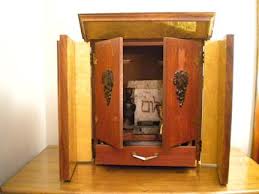 The dybbuk box, or dibbuk box (Hebrew: קופסת דיבוק, Kufsat Dibbuk), is a wine cabinet which is said to be haunted by a dybbuk. In Jewish folklore, a dybbuk is a restless, usually malicious, spirit believed to be able to haunt and even possess the living. The box achieved recognition when it was auctioned on eBay with an accompanying horror story and is the original inspiration for the 2012 film The Possession.
The dybbuk box, or dibbuk box (Hebrew: קופסת דיבוק, Kufsat Dibbuk), is a wine cabinet which is said to be haunted by a dybbuk. In Jewish folklore, a dybbuk is a restless, usually malicious, spirit believed to be able to haunt and even possess the living. The box achieved recognition when it was auctioned on eBay with an accompanying horror story and is the original inspiration for the 2012 film The Possession.The term "Dybbuk Box" was first used by Kevin Mannis to describe the box in the item information for an eBay auction to describe it as the subject of an original story (not the story for the film) describing supposedly true events which he considered to be related to the box. Mannis, a writer and creative professional by trade, owned a small antiques and furniture refinishing business in Portland, Oregon at the time. According to Mannis' story, he bought the box at an estate sale in 2001. It had belonged to a Holocaust survivor of Polish origin named, Havela, who had escaped to Spain prior to her immigration to the United States. Havela purposely sealed a dybbuk inside the box after it contacted her and friends performing a seance with a homemade oracle board.
On opening the box, Mannis found that it contained two 1920s pennies, a lock of blonde hair bound with cord, a lock of black/brown hair bound with cord, a small statue engraved with the Hebrew word "Shalom", a small, golden wine goblet, one dried rose bud, and a single candle holder with four octopus-shaped legs; all items supposedly used in Jewish folklore to exorcise demons.
Numerous owners of the box have reported that strange phenomena accompany it. In his story, Mannis claimed he experienced a series of horrific nightmares shared with other people while they were in possession of the box or when they stayed at his home while he had it. His mother suffered a stroke on the same day he gave her the box as a birthday present – October 28. Every owner of the box has reported that smells of cat urine or jasmine flowers and nightmares involving an old hag accompany the box. Iosif Neitzke, a Missouri student at Truman State University in Kirksville, Missouri and the last person to auction the box on eBay, claimed that the box caused electronic failure – phenomena from lights burning out in his house to computer failure, a mysterious insect swarm centering around the box, and unexplained medical conditions such as extreme and sudden hair loss. Jason Haxton, Director of the Museum of Osteopathic Medicine in Kirksville, Missouri, had been following Neitzke's blogs regarding the box and when he was ready to be rid of the box Neitzke sold it to Haxton. Haxton wrote The Dibbuk Box, and claimed that he subsequently developed strange health problems, including hives, coughing up blood, and "head-to-toe welts" His wife experienced "bloody, weeping, blisters" after coming in contact with clothing he wore during a failed containment attempt. His office also experienced the bursting of light bulbs, shared by Neitzke and Mannis and computer failures akin to Neitzke's experiences. Upon removal of the box from the museum, Haxton had locked the box in the back of his truck, parking it at his home in the evening. Haxton experienced nightmares of Hag-like women, not unlike Mannis's claims. The final straw, Haxton claims, happened while he and his son were watching television and his son noticed a black flame-like mass in the room with them. Haxton consulted with Rabbis to try to figure out a way to seal the dybbuk in the box again. Apparently successful, he took the freshly resealed box and hid it at a secret location, which he will not reveal.
Skeptic Chris French, head of the Anomalistic Psychology Research Unit at Goldsmiths' College, told an interviewer he believed that the box's owners were "already primed to be looking out for bad stuff. If you believe you have been cursed, then inevitably you explain the bad stuff that happens in terms of what you perceive to be the cause. Put it like this: I would be happy to own this object."